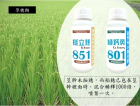| |

|

|
 |
 |
 |
| |
 |
HOW TO FERTILIZER RICE?
HOW TO CHOOSE DIFFERENT
GROWTH STAGES OF RICE?
|

The first crop season of rice in Taiwan usually falls from January to July, with variations depending on the climate in the northern to southern regions. The period includes the seedling stage, the vegetative stage, reproductive stage, and ripening stage.
Seedling Stage:
The rice seedling stage is the beginning of rice cultivation, which includes some prepare work such as seed selection, seed pre-treatment (soaked in water), disinfecting to prevent diseases, and initiate germination After the prepare work then sow the treated seeds uniformly in the seedling box or tray. The seeding amount for each seedling box or tray is depending on the size of the containers. The key to the first rice season seedling process is to avoid cold damage. Furthermore, provide a good seedling environment with proper humidity, sufficient light, and appropriate ventilation are also important for the seedling development.
Before transplanting, land preparation is necessary to prevent inconsistent node height in the future, which will affect the height of panicle and reduces the yield. Land preparation includes plowing, leveling the field, watering, and applying basal fertilizer. If needed to prevention and control the Apple Snail, can apply the Metaldehyde, Niclosamide, or Bitter Tea Extract 1-3 days before or on the day of transplanting. At the same time, maintain a water level of 1-3 cm to reduce snail movement. After a week, drain the water to reduce water system pollution.
Vegetative stage (Germination to Panicle Initiation):
Transplantation Stage (After transplanted to the field and root development) - Early tillering stage:
2-4 days after transplanting, use 5% Butachlor for weed control. Keeping the water level at around 3 cm can inhibit the growth of weeds and improve the effectiveness of the herbicide.
7-10 days after transplanting, it’s recommended to use Go Sprout 131(Special for lateral budding) to promote root system growth, lateral budding and increasing the survival rate. |
Early tillering stage - Late tillering stage:
12-15 days after transplanting, applying first top-dressing fertilizer. In order to provide enough nutrients to promote the rapid growth of plants in the early tillering stage. At this time, it is also important to do the pest control. Applying some herbicide when doing the top-dressing.
25-30 days after transplanting, it’s time to apply second top-dressing fertilizer. After the large use of nutrients nitrogen and potassium during the mid-late tillering stage, it is also recommended to use Si Force 851(Special for Poaceae, High in Silicon and Calcium), Its water-soluble silicon, lignin, and EDTA-Ca content thickens the cell walls of plants, enhancing the crops ability to stand upright and resist lodging.
At the late tillering stage, if the plants grow too crowded will cause the temperature and humidity increases in, there are the factors that cause the development of rice blast disease. Silicon (Si) can enhance the plant stress resistance. Molybdenum (Mo) can promote flower bud differentiation, preparing for panicle differentiation. When using antioxidants such as vitamin C and glutathione ensures antioxidant function of the plant is enhanced, and the plant uptake efficiency is improved.
Si Force 851 (Special for Poaceae, High in Silicon and Calcium), it is a slightly acidic solution that is compatible with pesticides such as mancozeb and tricyclazole for rice blast disease prevention. Applying foliar fertilizer together with pesticide without precipitation or antagonism, besides, it saves labor costs and labor works too.

|
Stem elongation stage:
About 50-60 days after transplanting, it is the stem elongation stage. Field drainage and drying are necessary at this stage to transform ammoniacal nitrogen into nitrate nitrogen. Plants no longer need the large amounts of nitrogen (N), is used for reducing the number of ineffective tillers. The leaves will turn from green to yellow-green, start to store starch and gradually becoming erect, preparing to form the panicles.
Reproductive stage: (Panicle Initiation to Flowering)
At this stage, should pay attention on stress tolerance and improving lodging resistance. During the panicle Initiation stage, applying appropriate amounts of fertilizer can increase the grain number per panicle, the fertility rate, and a thousand grain weight. As the panicle develop, the rice plant enters the booting stage, and then followed by the heading stage, which makes the plant quite sensitive to temperature, water, nutrients, and other stresses that affect rice quality. High nitrogen level may cause too many secondary branches on the panicle with poor quality of grains, and it is the factor to lodging in rice and infection with rice blast and sheath blight diseases. Therefore, it is important to focus on stress resistance and improving lodging resistance. (Uniform panicle development is better than heavy panicles)
During the reproductive stage, rice requires deep irrigation (About 5~10 cm). During the dry season in central and southern Taiwan, it is recommended to mix of Si Force 851 (Special for Poaceae, High in Silicon and Calcium) andCa Strong 801 (Special for Water Retention) can help to enhance the drought stress.
Ca Strong 801 contains appropriate amounts of nutrients and elements, silicon (Si) and sugar can enhance plant water retention; high potassium (K), high calcium (Ca), and xanthic acid can help regulate plant stomata; nucleotides can slow the plants senescence; betaine can regulate cell walls and prevent dehydration.

|
Reference:
1. 潘昶儒、陳吉村、楊大吉 (2009),農業經營專區技術叢書-水稻栽培管理手冊。
2. 王志瑄、朱盛祺、張素真,水稻健康管理技術應用於稻米品質之提升, 苗栗區農業專訊。
3. 賴文龍,水稻土壤管理及施肥技術。
4. 盧虎生(2004),水稻發育過程與健康管理,17~32,水稻健康管理研討會。
5. 水稻 (biodiv.tw), 莊溪,植物面面觀。
6. 稻作-水稻 (coa.gov.tw),作物病蟲害與肥培管理技術資料光碟。 |
|
|

|

|
 |
|
|
|